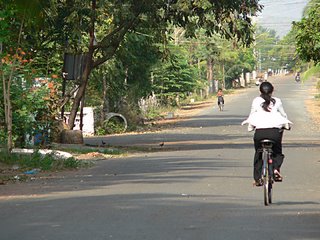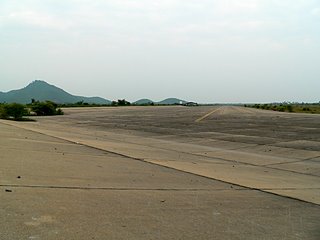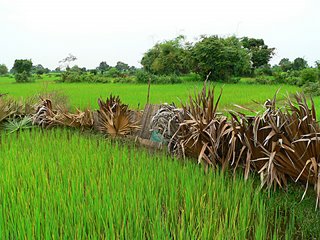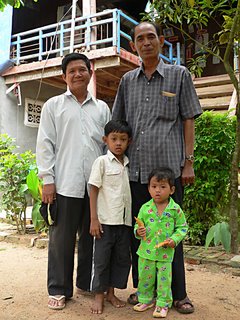Wednesday, October 25, 2006
Vietnamese, Cambodian or human?
 She was ahead of me on her bicycle as I rode mine towards the market. As she was riding quite slowly I pulled out to overtake her. I had just pulled ahead of her when she noticed me and started pedalling furiously to catch up.
She was ahead of me on her bicycle as I rode mine towards the market. As she was riding quite slowly I pulled out to overtake her. I had just pulled ahead of her when she noticed me and started pedalling furiously to catch up. 'Where you go?' she asked in English, the usual first question in this corner of the world.
'To the market.'
'Where you come from?'
'From Australia.'
'I Vietnamese.' Yes, her skin was on the light side compared to most Cambodians.
'How long have you been here?' I asked.
'24 years.' She looked about 16.
We talked on. The usual small talk for someone whose English is only basic. Eventually, I asked another of the usual questions for this corner of the world, 'How old are you?'
'Twenty-four.'
After a few more questions I realized she had been born here. She'd spent her whole life in Cambodia but she still called herself Vietnamese.
I have to wonder why we have this need to separate ourselves from other human beings. Me? If you ask where I was born I answer 'Australia'. If you ask my nationality, I answer 'Australian'. If you ask my ancestry, I answer 'English'. But if you ask what I am, then I am a human being.
*****
The flood has turned now but not before rising still higher. I took the opportunity to cycle through the flooded villages and also to take a boat ride through the extremely flooded ones. Photographs now showing on my flickr pages.
Sunday, October 22, 2006
Sita
Pol Pot and his first wife had no children. As he approached his sixties his revolution was losing ground and apparently he got the feeling that he would like to leave a child behind before he died.
He remarried and his new wife had a daughter who was named Sita. In 'Pol Pot, the history of a nightmare' Philip Short doesn't tell much about the daughter or Pol Pot's relationship with her just that he spent a lot of time with his wife and daughter in his mountain hideout.
One of his policies as Khmer Rouge leader was that parents did not own their children. After a certain age they became children of the community. So, did he also follow that policy with Sita or like so many of his other rules there was one for the masses and one for the leaders?
I have to wonder what sort of father he was. Was he kind to her? Did he abuse her? Probably you don't know the answers any more than I do but the questions are interesting. This man who is one of the worst abusers of humanity, how did he treat his child?
The other interesting thought is that now, I assume, Sita is still alive. Somewhere in Cambodia lives a young woman whose father was Pol Pot. Her mother remarried. I wonder if she changed her name. The new husband was also from the Khmer Rouge. Who knows? Is Sita aware of who her father was? She has to be, she was about ten when he died. That can't be wiped from her memory. What sort of person is she? How interesting it would be to have the opportunity to get inside her head.
He remarried and his new wife had a daughter who was named Sita. In 'Pol Pot, the history of a nightmare' Philip Short doesn't tell much about the daughter or Pol Pot's relationship with her just that he spent a lot of time with his wife and daughter in his mountain hideout.
One of his policies as Khmer Rouge leader was that parents did not own their children. After a certain age they became children of the community. So, did he also follow that policy with Sita or like so many of his other rules there was one for the masses and one for the leaders?
I have to wonder what sort of father he was. Was he kind to her? Did he abuse her? Probably you don't know the answers any more than I do but the questions are interesting. This man who is one of the worst abusers of humanity, how did he treat his child?
The other interesting thought is that now, I assume, Sita is still alive. Somewhere in Cambodia lives a young woman whose father was Pol Pot. Her mother remarried. I wonder if she changed her name. The new husband was also from the Khmer Rouge. Who knows? Is Sita aware of who her father was? She has to be, she was about ten when he died. That can't be wiped from her memory. What sort of person is she? How interesting it would be to have the opportunity to get inside her head.
Saturday, October 21, 2006
An attachment to being right
In 'Pol Pot, the history of a nightmare', Philip Short explains part of the philosophy adopted by the Khmer Rouge revolutionaries.
'The town-dwellers were to return to the land to reforge themselves, to reconnect with their Khmer roots. It was a trial, a rite of passage, from which they were expected to emerge strengthened, purified of the filth that came from city life.'
This reminds me of one of the shortcomings of we humans, which obviously includes me. We tend to believe that our way of doing things, our way of seeing the world, is always the correct way and that others should conform and be like us.
I suspect that a majority of the conflicts that beset this world at the moment are only happening because one, or more likely both, sides have this arrogant attitude. If only we could all give up this attachment to being right, what a better place the world might be.
After reading the above book, I am also wondering how much abuse, by parents, teachers, police and governments is done in the name of fixing someone who is supposedly bad. But is the fixer really being so good? Take this to the extreme and the fixer becomes Pol Pot.
*****
A few days ago there was an early morning storm. Later Vanna told me that his mother had said that was a sign—thunder over the river—now the flood will turn. The next day I went for my tofu and the water had risen another two centimetres.
'The town-dwellers were to return to the land to reforge themselves, to reconnect with their Khmer roots. It was a trial, a rite of passage, from which they were expected to emerge strengthened, purified of the filth that came from city life.'
This reminds me of one of the shortcomings of we humans, which obviously includes me. We tend to believe that our way of doing things, our way of seeing the world, is always the correct way and that others should conform and be like us.
I suspect that a majority of the conflicts that beset this world at the moment are only happening because one, or more likely both, sides have this arrogant attitude. If only we could all give up this attachment to being right, what a better place the world might be.
After reading the above book, I am also wondering how much abuse, by parents, teachers, police and governments is done in the name of fixing someone who is supposedly bad. But is the fixer really being so good? Take this to the extreme and the fixer becomes Pol Pot.
*****
A few days ago there was an early morning storm. Later Vanna told me that his mother had said that was a sign—thunder over the river—now the flood will turn. The next day I went for my tofu and the water had risen another two centimetres.
Wednesday, October 18, 2006
Wading for tofu

 At the bottom of my street is the local tofu factory. It's just a family business actually. They have a kitchen in the front yard where they make the tofu. That's it in the top picture with the flooded duck pond beyond.
At the bottom of my street is the local tofu factory. It's just a family business actually. They have a kitchen in the front yard where they make the tofu. That's it in the top picture with the flooded duck pond beyond.I eat tofu several times a week so I wander down and buy direct from the manufacturer. No discount. But at least I know it's fresh.
About a week ago Vanna told me that his mother said the flood had peaked now and should be turning in a few days. The next day I rode my bike down for my tofu and had to ride through about 10—12 cm of water. No big deal.
But the water didn't turn. By time I returned a couple of days later, the water was almost up to the cross-street. I tried to ride my bike through again. It was much deeper. I had to push on the pedals really hard. But some weeds or a stick got caught in the chain. It came off and jammed at the back. I had to get off and push through the rest of the water. It was perhaps twice as deep. And then, after buying the tofu, I had to push the bike all the way back. There is a small leaved weed floating on the water. That's the green you can see in both the pictures here.
The next time I returned for tofu I was smarter. I left the (now clean and repaired) bike at home. I walked and took my camera with me. The water was almost up to my knees. And I don't think it's peaked yet.
I am experimenting with using HTML : ) to link this blog to some of my flickr photos. If it all works, here is what you will find.
There is a close up picture of a beetle swimming through that weed. It shows clearly what the weed is like. I know. I had to wash it off my bike and legs several times. If all goes well, you'll find that photo here.
The tofu people have a dugout canoe which I guess they use to get their produce out of the place. There's a picture of it here.
Last weekend I cycled around (where I could get through) taking photos of the flood in other parts of town. Some can be compared with pictures I took during the dry season. You'll find many of them here.
Enjoy
Wednesday, October 11, 2006
Touring the province


 If you read this regularly you will know that Sarun is now living out of town. He has moved in with his daughter in a village called Pongero. It's about 9 k out of town, away from Phnom Penh, on Highway 5. Recently he invited me to come and visit so he could show me around the area where he grew up.
If you read this regularly you will know that Sarun is now living out of town. He has moved in with his daughter in a village called Pongero. It's about 9 k out of town, away from Phnom Penh, on Highway 5. Recently he invited me to come and visit so he could show me around the area where he grew up.I rode out on my bicycle which took about 45 minutes or so. I would have ridden straight past. Sarun had given me very clear directions except he said the market and their shop were on the right. Therefore I was sure I hadn't reached it yet when I saw his daughter waving and calling to me from the left.
Sarun and I went from there on his motorcycle. First we went to see Kompong Chhnang International Airport. As you can see from my first photo it used up a heck of a lot of concrete. It was built during the Pol Pot regime with Chinese money as a military airport. According to Lonely Planet it was never fully operational and it is rumoured that the Khmer Rouge leaders had all who worked on it killed to keep it a secret. There are also supposed to be plans to redevelop it for tourists, however from what Sarun tells me the people have no enthusiasm for anything that came from Pol Pot. Nearby buildings are derelict.
Returning along the quality concrete road built to service the airport we stopped to take a look at a fish trap in the rice fields. There is a creek running along the road but it is hard to pick it out as rice has been planted right through it. I noticed in many places that creeks have dams that let the water through but not the fish. The second photo is an example. The fish can't get through the palm leaves but they find the break and attempt to jump only to be caught in the trap.
Sarun asked me to take over the controls of the bike. First time I've done so in Cambodia and the first time for about three years. Gradually it all comes back except that his gears are upside down from what I'm used to.
We went to a village where something that looks like a stupa was built as a memorial to the local French commandant who was murdered by a villager who was unable to pay the taxes demanded. The memorial is overgrown with vines. No one cares for it. Obviously the commandant is still not respected. Almost across the road from the memorial we went to visit one of Sarun's friends who he told me was an English teacher.
The teacher was very friendly and he chatted to me in Khmer. I was pleased because most people here want to practise English with me which makes it difficult for me to practise Khmer. I figured he must be confident enough with his English to not feel the need to practise with me. We ran though all the usual questions that are customary when getting to know someone in Cambodia. We talked about each others family and ages and where I came from. I won't say I was fluent but I was pleased that I could carry on the conversation without any help. And he understood me : )
Next Sarun asked him to tell the story of the French commandant. I assumed now he would switch to English but he didn't. He continued in Khmer which Sarun translated as it was way beyond me. But why? I can only assume that despite being an English teacher when faced with a native English speaker he is shy about his ability to speak English.
The third photo shows Sarun with my new friend and his grandchildren. Sarun is the shorter one. I'm sorry, I didn't get the English teacher's name. Names are not considered important when getting to know someone in Cambodia.
We continued our sightseeing. I saw a lot of rice which I never tire of. The greens are beautiful—or have I mentioned that before. I didn't take more photos. I must already have hundreds. You can see a few of them on my flickr pages.
I had a delightful day. Makes me wonder why I don't have a motorcycle so I can enjoy this sort of thing more often.
Wednesday, October 04, 2006
Cambodia and global warming
 How does Cambodia stack up in efforts to reduce global warming? In an email newsletter I subscribe to I was sent a link to climatecrisis.net. They suggest ten things we can do to help reduce global warming. I decided to look at them from a Cambodian viewpoint.
How does Cambodia stack up in efforts to reduce global warming? In an email newsletter I subscribe to I was sent a link to climatecrisis.net. They suggest ten things we can do to help reduce global warming. I decided to look at them from a Cambodian viewpoint. 1. Change a light bulb—replacing one regular light bulb with a compact
fluorescent light bulb will save 150 pounds of carbon dioxide a year.
The electricity bill in the room I used to rent cost me around $US12 per month—say $140 per year. Compare that to the gross national income per capita of $US380 and you must understand that electricity is extremely expensive for the average Cambodian. Cambodians are already using small fluorescent tubes that are just a little better than a candle in both their homes and classrooms—that's the homes that have electricity.
2. Drive less—walk, bike, carpool or take public transport more often and
you'll save one pound of carbon dioxide for every mile you don't drive.
The most popular form of transport in Cambodia is the bicycle. The Cambodian version of carpooling is a share taxi—seven passengers and a driver in a Camry.
3. Recycle—you can save 2,400 pounds of carbon dioxide per year by
recycling just half of your household waste.
Most Cambodians drop their litter in the street. Anything that is recyclable is quickly picked up by a street kid who sells it so she/he can eat (or sniff glue). There is no household garbage collection where I live. Garbage, including a huge amount of plastic bags, is either buried or burned.
4. Check your tyres—keeping car tyres inflated properly can improve gas
(petrol) mileage by more than 3%. Every gallon of gasoline (petrol) saved
keeps 20 pounds of carbon dioxide out of the atmosphere.
There is no free air at Cambodian service stations. People have compressors at the side of the road and charge for each tyre they fill. Sometimes I wonder if people drive around with their tyres underfull because they hang out a little longer before forking out again. However, the mileage on a bicycle is not affected by tyre pressure.
5. Use less hot water—it takes a lot of energy to heat water. Use less
hot water by installing a low-flow shower head and washing your clothes in
cold or warm water.
I don't know anyone in Cambodia who has running hot water. For that matter I don't even have running cold water in my house. Low-flow shower head? I bathe by dipping a bowl into a tub of water and tipping it over my body. When I stay overnight in a guesthouse in Phnom Penh I can have a real shower. Such luxury. But still only cold water.
6. Avoid packaged products—you can save 1,200 pounds of carbon dioxide if
you cut down your garbage by 10%.
Like most people living in Kompong Chhnang I buy many foodstuffs—rice, flour, dried beans, etc—in bulk. It still ends up coming in a plastic bag. Suppose I could take my container to the market and ask them to fill it.
7. Adjust your thermostat—moving your heating thermostat just a few
degrees lower in winter and cooling up a couple of degrees in summer could
save you about 2,000 pounds of carbon dioxide with this simple adjustment.
Heating thermostat—you've got to be kidding! Temperatures rarely drop below 20° C. And despite temperatures in the high thirties and low forties every day in summer not many homes have air-conditioning. Maybe I can turn the fan speed down a notch.
8. Plant a tree—a single tree will absorb one tonne of carbon dioxide
over its lifetime.
Yeah, Cambodia is hacking down a lot of its rainforest. However, if you take a look at the picture of my backyard above, you'll understand I can hardly fit one more tree.
9. Turn off electronic devices—simply turn off your television, DVD
player, stereo and computer when they're not in use and you will save
thousands of pounds of carbon dioxide a year.
Television sets are not uncommon now in Cambodian homes. Mine has not been on since I moved in (language difficulties). I don't know anyone who owns a DVD player. Now, the person a few houses away who has their stereo up a little too loud, perhaps I could encourage them to turn it off for the sake of the environment. Only wealthy Cambodians own computers.
10. Spread the word—tell your family and friends so together we can make
a huge difference!
So what do I tell these people? Maybe I should pat them on the back. I think they're responsible for a lot less pollution than we in the West.